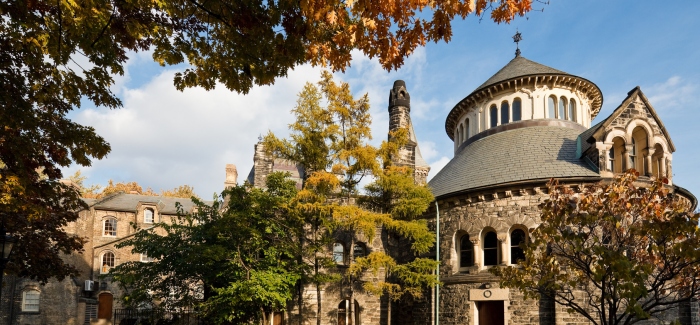One of the most famous cities in the world and a global capital of culture and business, New York City is also a highly important center of higher education. There are over half a million students in NYC, and more than 100 universities and colleges, of which an impressive 10 are included in the latest QS World University Rankings®.
From this vast array of options, two universities in New York stand out from the crowd: Columbia University and New York University (NYU). These two universities in New York City are ranked 16th and 43rd respectively in the 2019 world rankings, and they also feature in the top 10 in several of the 48 disciplines covered in the QS World University Rankings by Subject.
Between them, these two universities have produced a galaxy of famous alumni, from politicians (Barack Obama), business magnates (Warren Buffet) and writers (Allen Ginsberg, Jack Kerouac), to musicians (Lauren Hill), film directors (Martin Scorsese, Woody Allen) and fashion designers (Tom Ford).
Feel like following in their footsteps? Let’s take a closer look at each university’s strengths.
Choosing between the two top universities in New York City
Columbia University, traditionally seen as the academic big shot of the two, is part of the prestigious Ivy League, America’s most historically prestigious and selective institutions. However, far from living in its rival’s shadow, NYU has an identity and appeal all of its own.
Based in New York’s trendy downtown, and with tentacles spread throughout the city, NYU is a world-class university in its own right and boasts one of the world’s most dynamic environments for arts, music and culture. Whereas Columbia offers the relative seclusion of an Ivy League campus experience, NYU places students in the heart of the city. Based in arty Greenwich Village, with no walls or gates, the university is, as it proudly states, “in and of the city”.
As you might expect from world-renowned institutions in such a desirable location, admission to either institution is extremely competitive. Few students will be lucky enough to receive an offer from either, let alone both, but if you have good grades and are looking for the most exciting study experience the US has to offer, chances are at least one of these two top universities in New York City will be on your shortlist.
To help you decide which might be more suitable for you, here’s a look at how they compare.
|
|
Columbia |
NYU |
|
QS World University Rankings® 2019 |
Ranked 16th in the world Rated 12th in the world by academics and 23rd by employers 167th for research impact (citations per faculty member) 19th for faculty/student ratio 72nd for percentage of international students; 377th for percentage of international faculty |
Ranked 43rd in the world Rated 31st in the world by academics and 46th by employers 498th for research impact (citations per faculty member) 50th for faculty/student ratio 101st for percentage of international students; 463rd for percentage of international faculty |
|
Subject strengths* |
Ranked ninth in the world for arts & humanities Joint 81st in the world for engineering & technology Joint 26th for life sciences & medicine
18th for social sciences & management |
Ranked 11th in the world for arts & humanities Joint 145th in the world for engineering & technology Joint 49th for life sciences & medicine Joint 118th for natural sciences Joint 27th for social sciences & management |
|
Location |
Central campus is located in the upper west side of Manhattan. |
Six different locations in Manhattan, with a satellite campus in Abu Dhabi. Central campus is located in Greenwich Village, lower Manhattan. |
|
Student community |
Approx. 32,429 students enrolled (as of autumn 2017)
International students: 35 percent of total |
Approx. 59,061 students enrolled (as of 2017) 28,799 undergraduates; 24,706 graduate and professional students; 5,556 on non-credit programs International students: 22 percent of total |
|
Tuition fees |
For 2017-2018, undergraduate tuition was US$54,504 per year, plus other mandatory fees. |
For 2017-2018, undergraduate tuition fees for 12-18 credits varied from US$48,750 to $55,424 per year, plus other fees and charges. |
*Based on the broad subject areas in the QS World University Rankings by Subject 2018.
QS World University Rankings® 2019
Ranked 16th in the world this year, Columbia has been a consistent presence near the top of the world rankings over the past decade. Its prominent position reflects its solid reputation among employers and academics worldwide, two of the indicators used in compiling the QS rankings. In major global surveys of both employers and academics, Columbia ranked 23rd and 12th in the world respectively with each group.
These results indicate that academics across a broad range of disciplines have identified it among the world’s top universities in their field of expertise, while employers worldwide regard it as producing some of the world’s most employable graduates.
Despite trailing a little behind, NYU has nonetheless forged a strong reputation as a world-class institution. It’s ranked 43rd in the world overall, up nine places this year, and comes 31st in the academic reputation survey and 46th in the survey of employers.
Columbia has a higher rating both for its student/faculty ratio and its proportion of international students, getting its weakest score in the indicator assessing international diversity of faculty members. NYU also struggles in this category, ranking 463rd.
The biggest gap between the two is in the indicator assessing research citations per faculty member – a reflection of impact in the research world. Here, Columbia claims a substantial lead. It ranks 167th in the world to NYU’s 498th, making it perhaps a clearer choice for those interested in research-based programs.
Don’t go writing NYU off just yet though…
Subject strengths
Another factor to consider when assessing these two universities is their performance in the latest QS World University Rankings by Subject. A quick glance at the 2018 tables shows that both of these top universities in New York are best-established in the arts, humanities and social sciences, and both make the global top 10 in several subjects. NYU in fact claims second place in philosophy, with its next strongest positions in law (sixth), performing arts (ninth), and mathematics (11th). Columbia’s highest places are for anatomy & physiology (third), English language and literature (eighth), history (eighth) and modern languages (10th).
As the table below shows, there are some social science subjects, such as economics and law, in which the two are pretty much on a par. In other cases, one or the other has a clear lead – for instance, Columbia ranks much higher for physics, while NYU shines brighter in performing arts.
|
Columbia and NYU in the QS World University Rankings by Subject 2018 |
||
|
|
Columbia |
NYU |
|
Accounting & finance |
13th |
12th |
|
Anatomy & physiology |
3rd |
-- |
|
Anthropology |
13th |
20th |
|
Archaeology |
20th |
51-100 |
|
Architecture |
13th |
51-100 |
|
Art & design |
30th |
33rd |
|
Biological sciences |
17th |
39th |
|
Business & management |
=18th |
23rd |
|
Chemistry |
44th |
151-200 |
|
Classics & ancient history |
45th |
-- |
|
Communication & media studies |
11th |
15th |
|
Computer science |
24th |
33rd |
|
Dentistry |
39th |
=15th |
|
Earth & marine sciences |
=10th |
-- |
|
Economics |
10th |
15th |
|
Education |
13th |
=46th |
|
Engineering (chemical) |
51-100 |
151-200 |
|
Engineering (civil) |
51-100 |
-- |
|
Engineering (electrical) |
41st |
101-150 |
|
Engineering (mechanical) |
51-100 |
201-250 |
|
English language & literature |
8th |
13th |
|
Environmental sciences |
=37th |
201-250 |
|
History |
8th |
27th |
|
Law |
10th |
6th |
|
Linguistics |
101-150 |
42nd |
|
Materials science |
51-100 |
-- |
|
Mathematics |
14th |
11th |
|
Medicine |
14th |
33rd |
|
Modern languages |
10th |
=16th |
|
Nursing |
=33rd |
32nd |
|
Performing arts |
25th |
9th |
|
Pharmacy |
45th |
51-100 |
|
Philosophy |
18th |
2nd |
|
Physics & astronomy |
14th |
51-100 |
|
Politics & international studies |
10th |
34th |
|
Psychology |
12th |
11th |
|
Social policy & administration |
=11th |
=24th |
|
Sociology |
11th |
16th |
|
Statistics |
13th |
=48th |
|
Theology, divinity & religious studies |
21st |
51-100 |
Location
Columbia offers what might be described as a classic Ivy League campus experience: think stately quadrangles, neoclassical columns and immaculately maintained lawns. However, unlike other Ivy League institutions such as Princeton or Yale, Columbia is an island of calm in the middle of a bustling metropolis. It may be at the upper western tip of Manhattan, but it’s well within striking distance of all the action.
Nearby Harlem is one of the city’s most culturally diverse and dynamic neighborhoods – even if parts are still a little rough around the edges. And, also in close proximity, Central Park and the Hudson River offer some picturesque respite from New York’s famous urban jungle.
While for many students Columbia will offer the perfect combination of scholarly seclusion and proximity to the action, NYU offers a more immersive urban experience. With locations dotted around the city, the university’s main base is Greenwich Village, an area famous for its arty scene, and smack bang in the middle of New York’s cultural and social heart.
NYU’s central Washington Square location has no walls or gates separating it from the surrounding streets, which are filled with restaurants, bars and cafés. Studying here means you can expect to be at the center of one of the most culturally dynamic areas in the world.
New York itself is consistently ranked within the top 20 of the QS Best Student Cities ranking, with a score of 11th in the student view indicator, which is based on a survey asking students to rate their city on aspects such as affordability, ease of getting around, employment opportunities, arts and culture and more.
Student community
NYU has a significantly larger overall student population than Columbia, particularly when professional courses are included. However, both are at the larger end of the scale, offering large and diverse student communities – with Columbia offering a more diverse student body compared to NYU ( 35 percent of students are from outside the US, compared to 22 percent at NYU).
As befits its research-intensive status, Columbia is more heavily geared toward graduate studies, with graduates outnumbering undergraduates by more than two to one. NYU, by contrast, has more than three times the undergraduate population of Columbia, with a higher proportion of undergraduates than graduate students.
Fees and funding
Leading US private universities are notoriously expensive, and neither of these two top universities in New York is an exception to that rule. At both, international students are charged the same overall fees as those from within the US. Annual undergraduate tuition fees (plus other student fees) amount to US$48,750-55,424 at NYU for 2017-2018, while the 2017-2018 rate was a total of $57,208 (including other fees) at Columbia. At graduate level, fees vary depending on the graduate school and course, but master’s programs are likely to start at around $50,000-52,000 per year at both institutions.
At both schools, most students pay for their education through a combination of private savings, loans, scholarships and financial aid. Half of all Columbia students receive aid from the university, with the average amount awarded being $52,073. Similarly, a majority of students at NYU benefit from some form of financial assistance.
Like all US universities, both institutions provide net price calculators on their websites, which allow prospective students to get an estimate of how much they would be required to pay, and what financial aid they may be eligible for. NYU’s net price calculator can be found here, with a full range of funding options detailed here. Columbia’s net price calculator is here, with information about funding here.
This article was originally published in July 2013. It was last updated in June 2018 to include the latest data from the QS World University Rankings and other sources.
Want more content like this? Register for free site membership to get regular updates and your own personal content feed.













